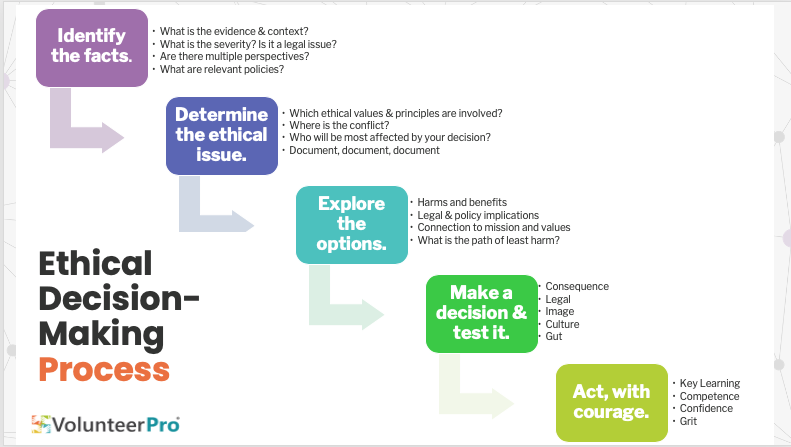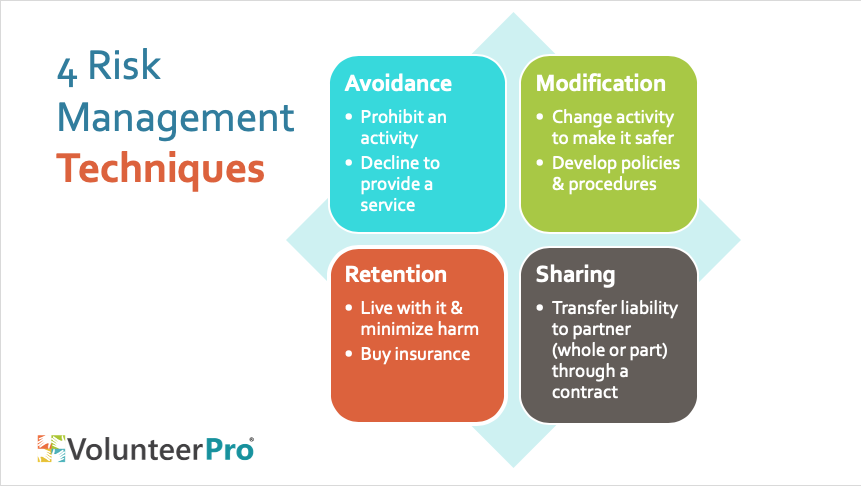 Volunteer Ethics & Risk Management: Should You Bring Volunteers In?
Volunteer Ethics & Risk Management: Should You Bring Volunteers In?
Considering the current pandemic, volunteer ethics are top of mind for nonprofits currently working on the front lines or who are planning to phase in operations over the next months.
Those that rely heavily on a volunteer workforce are understandably nervous about the chance that volunteers would be put in harm’s way. Equally, they are concerned about keeping urgently needed services active and, at the same time, protecting the health of their clients and customers.
It’s an ethical dilemma of huge proportions, with real consequences.
Gaps in the Legal Protection of Volunteers
In addition to ethics, volunteer organizations are worried about legal compliance, and for good reason.
To date, the practice of volunteer involvement has had little guidance in the terms of concrete laws, regulations, or ordinances. And, those that are in place, leave much to interpretation.
Here in the US, the Department of Labor offers limited guidance on the difference between volunteers and employees, as part of the Fair Labor Standards Act.
In addition, the Federal Volunteer Protection Act offers limited protection for volunteers from liability, but only under certain circumstances. In addition, many states have good samaritan laws that mimic the federal statute.
In the end, these laws don’t protect volunteers from lawsuits. And, sometimes they don’t protect volunteers at all. However, in some cases existing nonprofit insurance policies may cover volunteer liability. But that‘s not always the case.
What about protection of the health and safety of volunteers on the job?
Many nonprofits assume that their workers compensation insurance covers volunteers. Often, that isn’t the case. Under federal labor law, volunteers aren’t considered “employees.” In fact, in some states worker’s compensation benefits have been denied for volunteers. However, in your insurer’s eyes volunteers might be considered “workers” and offered coverage.
Alternately, organizations may believe that federal workplace health and safety laws have authority over volunteers. However, the US Occupational Safety and Health Administration has noted in at least one opinion letter that volunteers are not protected by OSHA standards.
Confused yet?
In addition, nonprofits can buy accident insurance that can protect volunteers and those they serve. However, it isn’t a given that this is already included in your existing policy.
What about waivers? If a volunteer signs a waiver does that hold the organization harmless?
Often nonprofits believe they are protected if they have volunteers sign a release of liability or waiver.
However, it’s unlikely that a waiver would protect an organization that had not performed their own due diligence and standard of care of volunteers.
Would asking volunteers to serve on the front lines of a pandemic be considered a lack of due diligence? Since we find ourselves in a novel situation, this is still untested.
In addition, consider the message a waiver sends to an altruistically motivated volunteer. “Yes, we’re desperate for your help. But no, we’re not willing to assume any responsibility for your well-being. That’s entirely on you.”
You get the gist.
In the end, the two key reference points for clarity for your organization is your agency’s attorney or legal team and your insurance carrier. While we can point out some of the possible challenges here, a licensed professional is needed to help you navigate your organizations’ unique circumstances.
The Risks Inherent in the Volunteer Enterprise
In addition to legal liability, nonprofits should consider how to assess, manage, and mitigate the risks of volunteer involvement, both during a pandemic and in the regular course of operations.
The reliance on sheer luck won’t get you far. And, if a lawsuit were to rear its ugly head, your agency would need to show proof of due diligence in the form of risk management policies and procedures.
In addition, proper risk management is more than just keeping terrible things from happening – it also helps you make better planning and management decisions.
I’ve written before about the upside of proper volunteer risk management and the ways active risk management can help you, now and in the future.
In the end proper risk management is synonymous with proper volunteer program administration.
In today’s climate, the vulnerabilities and lack of planning around the risks associated with volunteer involvement have become clear for many organizations.
Five Risks in Volunteer Involvement
There are five diverse types of risk to consider in any context, including the current crisis. These are inherent with any volunteer involvement, but are also present with employees as well.
And, while they exist, it doesn’t necessarily mean that volunteerism isn’t possible.
Volunteer involvement includes risks to …
- People – the possibility of inappropriate volunteer-client/caregiver boundary setting (both emotional and physical), particularly vulnerable to transgression during a crisis
- Property – theft, loss, damage to equipment, including personal protective equipment (PPE)
- Reputation – the damage to your community credibility, both as a service provider but also as a workplace
- Income – the loss of grant or contract funding, as well as individual giving (often driven by reputation)
- Liability – for supporting the health and safety of volunteers, employees, partners, and those you serve
As busy organizations with limited resources, nonprofits can’t manage every risk, but it is the responsibility of every organization to assess and prioritize the risks inherent in their work and arrive at a plan of action.
Prioritization also helps organizations use their resources wisely and helps you be accountable to others around your chosen risk management strategy.
Of the risks currently at play in your organization, consider the likelihood of occurrence and magnitude of harm of each on a scale of low, medium, or high. Anything with a high or medium likelihood and a high or medium significance deserves real attention and a strategy.
For example, consider if you were to bring volunteers onboard to distribute food to needy people in your community with a high rate of COVID-19 infections. What is the likelihood they might also get infected? What is the possible magnitude of harm if they contract the virus through their work with you – to both their health and your reputation?
It’s something to consider seriously.
In some cases, the risks are associated with not being able to offer required services due to lack of personnel.
This poses a clear ethical dilemma for volunteer-driven organizations. Do we risk the health of volunteers in order to save the lives of others?
Volunteer Ethics in Times of Crisis
When it comes to ethical practice in volunteerism, there are clear guidelines.
The Council for Certification in Volunteer Administration (CCVA) updated its values and principles in 2016. The current CCVA Professional Ethics in Volunteer Management, developed by a group of practitioners and stakeholders, is an exceptional tool to ground and guide the practice of volunteer involvement, whether in a crisis or not.
CCVA Ethical Core Values & Principles (2016)

What’s challenging, however, is that the current core values and principles don’t cover volunteer safety.
So, it is left to organizations to figure this out on their own.
Your agency’s core values are a helpful decision-making tool in times of crisis.
The following questions can help you begin to align your values with how you evaluate your decisions:
- What are your agency’s stated values & guiding principles?
- How can you model them during this crisis?
- How can you use them for prioritization and decision-making?
- Which are most vulnerable currently?
In addition, following a structured decision-making process can help ensure that you are carefully weighing the options and not arriving at ill-considered solutions on the fly.
Having a process is helpful and effective because it …
- Promotes a fuller understanding of the situation
- Avoids a knee-jerk reaction based on personal ethics or bias
- Encourages creative thinking and multiple perspectives about workable solutions
- Offers a safe way to explore distinct options for action
- Results in a decision that is justifiable (if someone questions why, you can present your rationale)
Ethical dilemmas abound when engaging a volunteer workforce, but even more so during a global pandemic.
By definition, an ethical dilemma is “a situation in which a difficult choice has to be made between two courses of action, either of which entails transgressing a moral principle.”
Ethics can be personal, professional, or organizational, but they always involve the tough choice between two or more competing priorities.
So, making a final decision becomes more challenging.
Ethical Decision-Making Process: Step by Step

When faced with an ethical dilemma, the following is a process you can use to determine your next steps (hat tip to Katie Campbell from CCVA for her wisdom and training on this years ago).
-
- STEP 1: Identify the facts.
-
-
- What is the evidence & context?
- What is the severity? Is it a legal issue?
- Are there multiple perspectives?
- What are relevant policies?
- STEP 2: Determine the ethical issue.
-
-
-
- Which ethical values & principles are involved?
- Where is the conflict?
- Who will be most affected by your decision?
- Document, document, document
- STEP 3: Explore the options.
-
-
-
- Harms and benefits
- Legal & policy implications
- Connection to mission and values
- What is the path of least harm?
-
-
- STEP 4: Make a decision & test it.
-
-
- Consequence
-
- Legal
- Image
- Culture
- Gut
-
-
- STEP 5: Act with courage.
-
-
- Key Learning
- Competence
- Confidence
- Grit
-
When you’re ready to test your final decision, consider the following questions:
- Consequences: What are the consequences if I do this? Who will benefit? Who will suffer?
- Legal: Is this action legal? Are there considerations based on laws?
- Image: Would I be comfortable seeing this decision announced in the newspaper (or on Facebook)? Will this decision hurt or harm our public image?
- Culture: Does this decision support or damage our organization’s culture and values?
- Gut: What does my intuition tell me? Does this action cause a knot in my stomach? Would my parents, mentor, children approve?
There’s no doubt that making a final decision about an ethical dilemma is tough. But, not acting can be ask risky as teams are asked to act without guidance or leadership.
So, take the bold steps needed to move forward on one path or another.
Managing Volunteer Risk in Today’s Crisis
If a nonprofit chooses to move forward with an action that may involve risk, management strategies can be put in place to reduce or mitigate harm. This does not always mean that harm is eliminated.
There are four common ways to manage risk. At least one should be put in place for each medium or high priority risk in play.
4 Risk Management Techniques

In the case of volunteer involvement during COVID-19, the risk management options might include any of the following or more:
- Avoidance
-
- Prohibiting volunteers from taking part in certain activities or certain worksites
- Temporarily closing a volunteer–driven service
- Modification
-
- Changing an activity to make it safer with personal protective equipment (PPE) and social distancing requirements
- Developing policies and procedures for checking for active infection before work
- Retention
-
- Deciding that the risk is unavoidable and minimizing harm where possible
- Adding insurance coverage for liability and safety of volunteers
- Sharing
-
- Transferring liability to the volunteer (in whole or part) through a waiver (see discussion above on waivers)
To ensure proper risk management, organizations might also choose to phase in volunteer involvement though small pilot tests. That way, vulnerabilities in systems can be found and mitigated further before involving a larger group.
The current COVID-19 crisis has revealed many legal, ethical, and risk-related vulnerabilities to volunteer engagement. While organizations grapple with the implications in their specific contexts, they might also think to the future.
How can these issues be resolved so that volunteers and organizations are protected both now and into the future?
How can we ensure the future sustainability of the volunteer effort and make volunteerism safe for all?








Leave A Comment